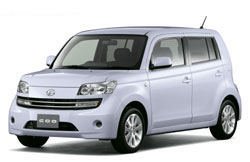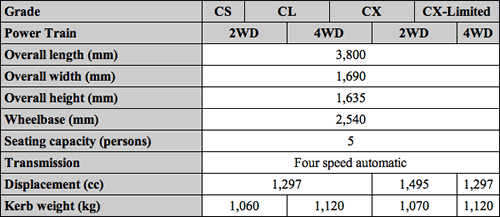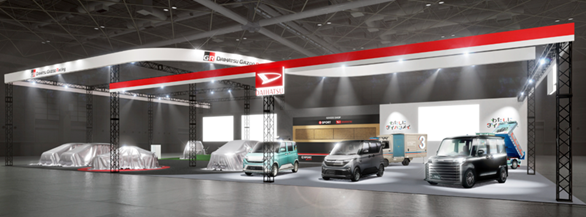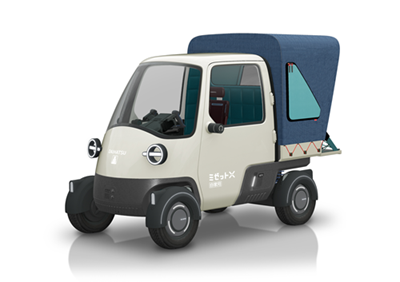- Products / Technology
- Vehicle
- NEWMay. 08, 2006
Daihatsu Launches New Compact Passenger Car COO
May. 08, 2006
 Daihatsu COO 1.5CX 2WD
Daihatsu COO 1.5CX 2WD
DAIHATSU MOTOR CO., LTD. (Daihatsu) announced the launch in Japan of the new compact passenger car COO on May 8.
As customer needs in the compact vehicle market, where ease of handling and superior fuel efficiency are highly valued, continue to diversify, the COO was developed as a vehicle that expresses strong individuality in all situations based on the concept of being a unique and emotional multi-purpose vehicle. The exterior and interior styling are distinctive yet appealing to the senses, and despite compact body dimensions, its high-efficiency layout offers an interior space that can comfortably accommodate five adults. The COO is designed to serve as a multi-purpose vehicle for the whole family.
The COO is targeted at young families and young married women, and satisfies the desire of minivehicle users to move up to higher-end vehicles.
The new COO offers the following features:
1) Unique exterior and interior styling that delivers a sense of presence
2) Functional package that families can use in a variety of different situations
3) Comfortable ride, as well as high safety and environmental performance
Plans call for sales of 1,000 units per month in Japan. The manufacturer’s suggested retail prices (exclusive of consumption tax) range from 1.3 million yen to 1.784 million yen. (The photo shows the 2WD Grade CX model with a manufacturer’s suggested retail price of 1.540 million yen).
Vehicle Overview
Exterior styling that uses bold curves to project a sense of presence
- A form with a sense of presence has been designed to convey the feel of refined individualism in a robust vehicle body that projects security and stability with a short front overhang and wheels located deep in the four corners.
- Vertical grooves running along the surface of the front grille and bumper present a sharp and powerful front view.
- A crisp and forceful side view was created by the use of doors with unique concave surfaces, and dynamic character lines that run high on the sides.
- The rear view has an open feel and a subtle elegance, due to the distinctive hatch door glass with its gently arcing shape, and hatch door garnish that connects the left and right rear combination lamps.
- Eight color variations are available, including three new colors (Bluish White Pearl Mica, Yellow Green Mica Metallic, and Dark Red Mica).
New interior that projects an individualism that appeals to the senses
- The creative and individualistic interior design uses a round instrument panel with a large arc shape to create a cabin area that gently surrounds the occupant with a feeling of relaxation.
- The two-part central instrument panel enables instrument reading with minimal eye movement, and easy-to-use operational controls result in ease of driving.
- The front passenger area boasts a bench seat that is amply wide and deep and has a comfortable sofa-like feel. All models feature a height-adjustable driver's seat as a standard feature.
- The rear seatback features a left-right independent reclining function and the seats have a sliding range of 240mm* to achieve a comfortable rear-seat cabin space and a large luggage space.
- A fabric in matte tones and a glossy checkerboard pattern fabric are used for the seat covering to produce a high quality feel.
* For the 2WD drive models (220mm for the 4WD models)
Packaging and Utility
Superior comfort and large luggage capacity in an easy-to-handle vehicle body with compact dimensions
- A class-leading*1 interior length of 1,940mm and interior width of 1,420mm have been achieved in a vehicle body with compact dimensions (a total length of less than 4m). The interior space can comfortably accommodate five adults.
- Giving a sliding range of 240mm*2 to the rear seats resulted in a distance of 955mm*3 between the front and rear seats, one of the longest in the class*1 .
- When only two occupants are on board, the vehicle boasts a large cargo capacity of 619 liters*4 .
- Rear seats with sliding mechanisms and seatbacks that can be reclined and tumbled forward independently provide a versatile seat arrangement.
- Despite the use of wide-tread tires, the COO has achieved a minimum turning radius of 4.9m.
*1 Within the same displacement class (based on a survey by Daihatsu in April 2006)
*2 For the 2WD drive models (220mm for the 4WD models)
*3 Measured by Daihatsu
*4 Measured by Daihatsu using the VDA method
Engine and Other Key Mechanisms - Superior acceleration performance and comfortable ride
| Model | Displacement | Maximum output (kW(PS)/rpm) |
Maximum torque (N·m(kg·m)/rpm) |
Fuel consumption (km/l) in the 10-15 Japanese test cycle | |
|---|---|---|---|---|---|
| 2WD | 4WD | ||||
| K3-VE | 1,297cc | 68(92)/6,000 | 123(12.5)/4,400 | 16.4 | 15.2 |
| 3SZ-VE | 1,495cc | 80(109)/6,000 | 141(14.4)/4,400 | 16.0 | - |
- Uphill shift control is adopted for the electronically controlled 4-speed automatic transmission that provides a comfortable drive and achieves high fuel efficiency through high transmission efficiency, resulting in smooth driving performance.
- A comfortable ride and superior maneuvering and driving stability have been achieved by increasing the rigidity and reducing the weight of various components, coupled with dedicated suspensions with large strokes.
Safety performance - Enhanced safety features and collision safety performance that are among the highest in its class
- An improved collision-safety body TAF (Total Advanced Function) has been used, incorporating the concept of compatibility to ensure the survival of the occupants of both vehicles when two vehicles of differing weights collide with each other.
- The results of omni-directional, vehicle-to-vehicle collision tests conducted at 55km/h, and other collision tests that combine the stringent testing methods being used in various countries worldwide demonstrated that the COO not only satisfies Japanese safety standards but also preserves an ample survival space, achieving a high level of occupant safety performance.
- A pedestrian-injury-lessening body structure was used that incorporates impact-absorbing structures into the cowl and bonnet to ensure the protection of the particularly vulnerable head area of the pedestrian in the event of a pedestrian-vehicle collision.
- The interior is based on the concept of SOFI (Safety-Oriented Friendly Interior).
- Dual SRS (Supplemental Restraint System) airbags for the driver and passenger seats are standard on all vehicles. Further, SRS curtain shield airbags for all seats and SRS side airbags for the driver and passenger seats are available as custom options.
- The COO comes standard with 3-point ELR (Emergency Locking Retractor) seatbelts equipped with pretensioners and force limiters for the front seats to increase the safety of the front-seat occupants.
- The rear seats in all models are provided with ISO-FIX compliant child seat mounts with top tether anchor.
- All models feature ABS with EBD (Electronic Brake-force Distribution) and Brake Assist that prevents the wheels from locking under severe braking.
- The COO offers VSC (Vehicle Stability Control), which combines three control systems - ABS for preventing the wheels from locking during braking, TRC for preventing the driving wheels from slipping during acceleration, and sideway skidding control during cornering - to ensure the vehicle's stability during abrupt steering wheel operations or on slippery road surfaces. (available as an option in the 1.5-L 2WD version of the CX and CX-Limited).
Environmental Performance - Offers a high level of environmental performance that ensures resource recovery even for the precious metals used in the catalytic converter
- All models are equipped with the Intelligent Catalyst that was first developed by Daihatsu. The Intelligent Catalyst provides a self-regenerative function to the precious metal palladium minimizing deterioration of its exhaust gas purification performance and reducing usage by about 70%, thus contributing to the conservation of resources.
- All vehicles achieve emission levels 75% lower than 2005 standards under the Ministry of Land, Infrastructure and Transport’s Approval System for Low-emission Vehicles, and 2WD vehicles achieve the Japanese 2010 fuel efficiency standards.
- A review of the materials and adhesives used in interior parts resulted in a reduction in the amount of VOCs (volatile organic compounds, such as formaldehyde, which can cause unpleasant odors and irritate the nose and throat) released, to a level lower than the indoor concentration specified by the Ministry of Health, Labour and Welfare.
Main Specifications







